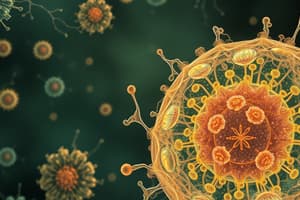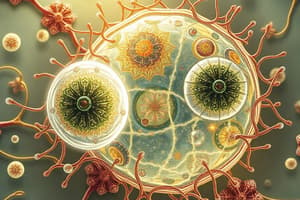Podcast
Questions and Answers
What is a characteristic feature of eukaryotic cells?
What is a characteristic feature of eukaryotic cells?
- They lack a nucleus.
- They are unicellular only.
- They contain membrane-enclosed organelles. (correct)
- They reproduce asexually only.
Which process is involved in gene expression?
Which process is involved in gene expression?
- Fermentation.
- Cell division.
- Transcription. (correct)
- Photosynthesis.
What does genomics study?
What does genomics study?
- Whole sets of genes. (correct)
- The processes of cellular respiration.
- Whole sets of proteins.
- The properties of individual proteins.
Which domain includes prokaryotic cells that lack a nucleus?
Which domain includes prokaryotic cells that lack a nucleus?
What is true about the Tree of Life?
What is true about the Tree of Life?
Which statement accurately describes chromosomes?
Which statement accurately describes chromosomes?
What does the field of proteomics focus on?
What does the field of proteomics focus on?
What is the main purpose of scientific inquiry?
What is the main purpose of scientific inquiry?
What is the smallest unit of organization that can perform all activities required for life?
What is the smallest unit of organization that can perform all activities required for life?
Which term describes a group of similar cells that work together to perform a specific function?
Which term describes a group of similar cells that work together to perform a specific function?
What is an example of an emergent property?
What is an example of an emergent property?
How are structure and function related in biological organization?
How are structure and function related in biological organization?
What characteristic do all cells share?
What characteristic do all cells share?
Which term refers to the global sum of all ecosystems on Earth?
Which term refers to the global sum of all ecosystems on Earth?
What is the first step of the scientific method?
What is the first step of the scientific method?
Which type of data consists of numerical measurements?
Which type of data consists of numerical measurements?
What allows a hummingbird to fly backward?
What allows a hummingbird to fly backward?
What do we call a group of individuals of the same species living in a specific area?
What do we call a group of individuals of the same species living in a specific area?
What does the control group represent in an experiment?
What does the control group represent in an experiment?
How does a theory differ from a hypothesis?
How does a theory differ from a hypothesis?
Why is communication important in scientific collaboration?
Why is communication important in scientific collaboration?
What is the significance of diverse viewpoints in science?
What is the significance of diverse viewpoints in science?
Which of the following is not considered a level of biological organization?
Which of the following is not considered a level of biological organization?
What role do independent variables play in experiments?
What role do independent variables play in experiments?
What is meant by emergent properties in biological organization?
What is meant by emergent properties in biological organization?
How does genomics contribute to our understanding of biology?
How does genomics contribute to our understanding of biology?
What is the main role of model organisms in scientific research?
What is the main role of model organisms in scientific research?
What defines the information theme in the study of life?
What defines the information theme in the study of life?
Which statement regarding the representation of marginalized groups in science is accurate?
Which statement regarding the representation of marginalized groups in science is accurate?
Which of the following best describes the role of feedback regulation in biological systems?
Which of the following best describes the role of feedback regulation in biological systems?
Which of the following statements regarding energy and matter in biological systems is accurate?
Which of the following statements regarding energy and matter in biological systems is accurate?
What is the purpose of the camouflage hypothesis?
What is the purpose of the camouflage hypothesis?
Why is bioinformatics important in the field of genomics?
Why is bioinformatics important in the field of genomics?
Which of the following is considered the independent variable in the experiment?
Which of the following is considered the independent variable in the experiment?
What did the control group consist of in the experiment?
What did the control group consist of in the experiment?
What was the dependent variable measured in the study?
What was the dependent variable measured in the study?
What can be inferred from the results showing lower predation rates for camouflaged models?
What can be inferred from the results showing lower predation rates for camouflaged models?
In the experiment conducted by Hopi Hoekstra and colleagues, what two habitats were tested?
In the experiment conducted by Hopi Hoekstra and colleagues, what two habitats were tested?
Which of the following best describes the purpose of using both camouflaged and non-camouflaged models?
Which of the following best describes the purpose of using both camouflaged and non-camouflaged models?
What might a scientist conclude if they observed high predation rates in camouflaged models?
What might a scientist conclude if they observed high predation rates in camouflaged models?
Flashcards are hidden until you start studying
Study Notes
The Cell: Basic Unit of Structure and Function
- Cells are the smallest units capable of performing all life activities.
- Cell theory states all living organisms are made of cells.
- Prokaryotic cells lack a nucleus and membrane-enclosed organelles.
- Eukaryotic cells have a nucleus and membrane-bound organelles.
Genetic Information
- DNA encodes genetic information, consisting of long molecules in chromosomes.
- Each gene is a unit of inheritance that instructs the synthesis of cellular molecules.
Gene Expression
- Gene expression converts gene information into cellular products through transcription (DNA to RNA) and translation (RNA to protein).
Genomics and Proteomics
- Genomics studies gene sets across species.
- Proteomics focuses on the entire set of proteins and their properties.
Evolution
- Evolution explains the unity and diversity of life on Earth.
Three Domains of Life
- Bacteria: Prokaryotic organisms without a nucleus or organelles.
- Archaea: Similar to bacteria but often found in extreme environments.
- Eukarya: Domain with eukaryotic cells containing nuclei and organelles.
Biodiversity
- Approximately 1.8 million species have been identified.
- Species are named using a two-part Latin naming system (genus and species).
Scientific Method
- Steps include making observations, forming hypotheses, testing, and analyzing data.
- Experimental data can be qualitative (descriptive) or quantitative (numerical).
Variables and Controls in Experiments
- Independent variable: manipulated by researchers.
- Dependent variable: measured and expected to change in response.
- Control group: unexposed to the independent variable for comparison.
Theories in Science
- Theories are broader than hypotheses and supported by extensive evidence, leading to new testable hypotheses.
Importance of Teamwork in Science
- Collaboration enhances scientific success; diverse viewpoints lead to innovative ideas.
Levels of Biological Organization
- Molecule: basic structures like DNA and proteins.
- Cell: smallest living unit.
- Tissue: group of similar cells performing a function.
- Organ: structure composed of different tissues serving a role.
- Organ System: group of organs working together.
- Organism: individual living entity.
- Population: group of the same species in a specific area.
- Community: interacting groups of different species.
- Ecosystem: community interacting with non-living components.
- Biosphere: global sum of all ecosystems.
Emergent Properties
- Properties arise from interactions and organization of components, not inherent in individual parts.
- Example: Photosynthesis only occurs in intact chloroplasts.
Structure and Function Correlation
- Structure influences function across biological levels, such as the flat shape of leaves enhancing sunlight capture.
Camouflage Hypothesis Experiment
- Explores if coat coloration impacts predation rates in Peromyscus polionotus mice.
- Independent variable: color of mice; dependent variable: predation rates.
Scientific Analysis
- Camouflaged models show lower predation rates, supporting the camouflage hypothesis.
Demographic Representation in Science
- Women, people of color, and other marginalized groups are underrepresented but increasing in several fields.
The Study of Life: Unifying Themes
- Emergent properties: new traits appear at higher organization levels.
- Genetic information: encodes life processes and is transmitted from parents to offspring.
Energy and Matter Theme
- Energy moves through ecosystems; producers convert sunlight to chemical energy, which supports consumers.
Interaction Theme
- Biological systems are driven by feedback regulation: negative feedback slows production of end products while positive feedback accelerates it.
- Organisms continuously interact with their environment for survival.
Studying That Suits You
Use AI to generate personalized quizzes and flashcards to suit your learning preferences.




